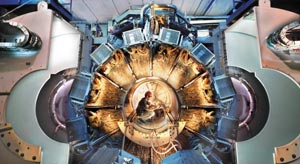
It is a classic example of the question to ask aliens from a distant galaxy to discover if they are made from what we on Earth define as matter or antimatter. Tell them to make neutral B mesons and anti-mesons and measure the decays to Kπ pairs. Then ask whether the sign of the kaon in the most frequent decay has the same or opposite sign to the lepton orbiting the atoms that make up the galaxy’s matter. If the answer is “yes”, then the aliens are made from what we know of as antimatter, and it might be better not to invite them to visit Earth.
This in short is the experiment in which the BaBar collaboration at SLAC has observed direct CP violation in the neutral B-meson system – detecting the subtle effect that reveals a difference between the decays of particles and their antiparticles. Both BaBar and the Belle experiment at KEK in Japan have already established that CP violation occurs in the B-meson system, however, the earlier results related to processes that involve B0-Bbar0 oscillations. The key word with the latest measurements is “direct”, as the BaBar collaboration has now observed CP violation in a process that does not involve oscillation, the decay of the neutral B meson to a Kπ pair.
The BaBar team of 600 physicists and engineers from 75 institutions in Canada, China, France, Germany, Italy, the Netherlands, Norway, Russia, the UK and the US, has studied the decays of 227 million ϒ(4S) particles to B-Bbar pairs and selected the decays B0 → K+π– and Bbar0 → K–π+. If CP symmetry were exact, then the two decays would be equally likely to occur, and by starting with equal numbers of Bs and Bbars the experiment should end up with equal numbers of K+π– and K–π+ pairs.
However, BaBar found more K+π– pairs than K–π+ pairs in a total, nK-π+ + nK+π-, of about 1600 events. The results yield an asymmetry of (nK-π+ – nK+π-)/(nK-π+ + nK+π-) = -0.133± 0.030 (stat) ± 0.009 (syst), establishing direct CP violation in the B0-meson system at the level of 4.2σ (Aubert et al. 2004). The Belle collaboration has recently published the result of a similar analysis based on around 1000 decays, in which they find an asymmetry of -0.088 ± 0.035 ± 0.013, but with a significance of 2.4σ (Chao et al. 2004). Belle has also reported evidence for direct CP violation at the level of 3.2σ in the decays B0 → π+π– (Abe et al. 2004).
Direct CP violation was observed first in neutral kaons, in the NA48 experiment at CERN and the KTeV experiment at Fermilab. However, as expected theoretically, the effect now observed in the B0 system is much larger. With an asymmetry of 13% measured by BaBar, the phenomenon is some 100,000 times stronger in neutral B mesons than in kaons.
Further reading
K Abe et al. 2004 Phys. Rev. Lett. 93 021601.
B Aubert et al. 2004 www.arxiv.org/abs/hep-ex/0407057.
Y Chao et al. 2004 www.arxiv.org/abs/hep-ex/0407025.








